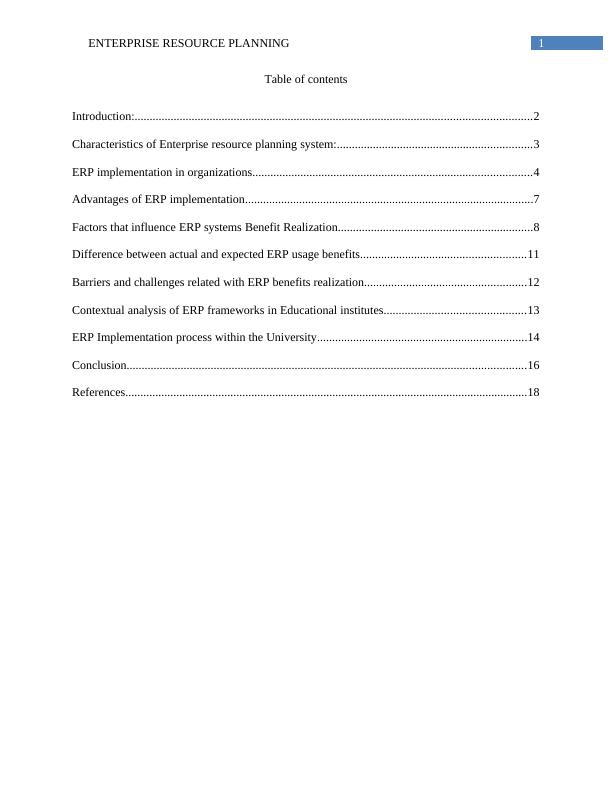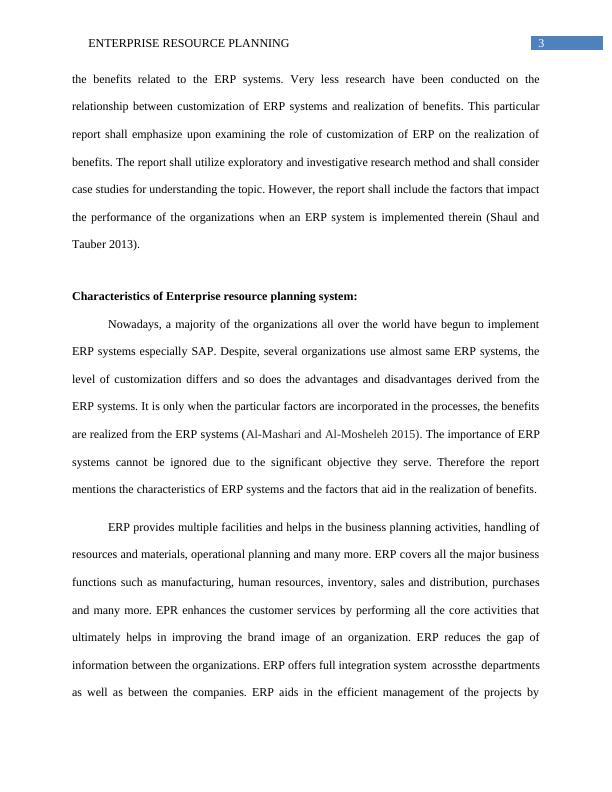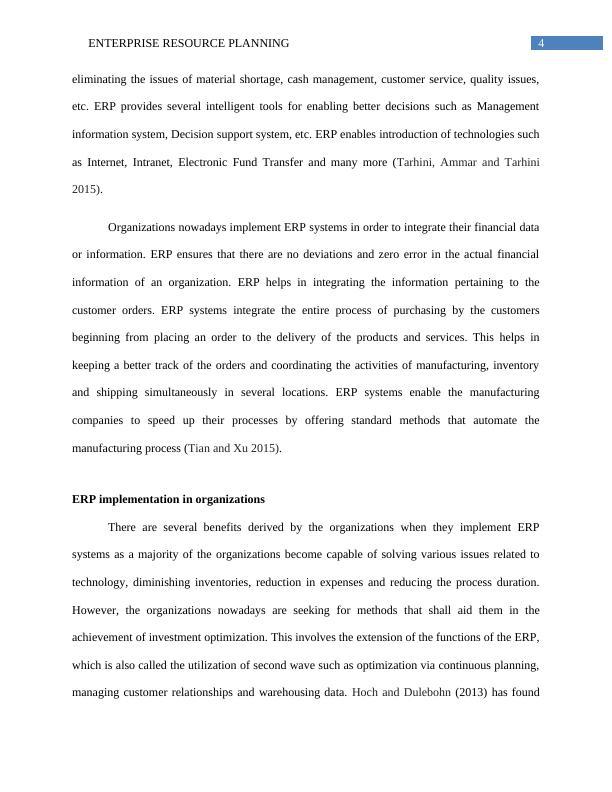Introduction to Enterprise Resource Planning System: Characteristics of Organizations
22 Pages5629 Words219 Views
Added on 2020-03-04
About This Document
Enterprise resource planning refers to the fully integrated management of the major business processes such as production, finance, logistics, human resources, and accounting. Enterprise resource planning has evolved from a Material requirement Planning system that integrates the information between manufacturers, suppliers, and customers with the help of the Internet, WAN, etc. Enterprise resource planning is a people project as they are the people who design suitable ERP systems, implement them within an organization and accept the implementation of ERP systems.
Introduction to Enterprise Resource Planning System: Characteristics of Organizations
Added on 2020-03-04
ShareRelated Documents
Running head: ENTERPRISE RESOURCE PLANNINGEnterprise resource planningName of the student:Name of the University:Author note:

1ENTERPRISE RESOURCE PLANNINGTable of contentsIntroduction:....................................................................................................................................2Characteristics of Enterprise resource planning system:.................................................................3ERP implementation in organizations.............................................................................................4Advantages of ERP implementation................................................................................................7Factors that influence ERP systems Benefit Realization.................................................................8Difference between actual and expected ERP usage benefits.......................................................11Barriers and challenges related with ERP benefits realization......................................................12Contextual analysis of ERP frameworks in Educational institutes...............................................13ERP Implementation process within the University......................................................................14Conclusion.....................................................................................................................................16References......................................................................................................................................18

2ENTERPRISE RESOURCE PLANNINGIntroduction:Enterprise resource planning refers to the fully integrated management of the majorbusiness processes such as production, finance, logistics, human resources and accounting.Enterprise resource planning integrates the business processes and the flow of the informationwithin an organization in order to ensure optimum utilization of organizational resources such asmen, money, material and machine (Leon 2014). Enterprise resource planning ensures onedatabase, single user interface and single application. With the rapid growth in the businessenvironment, the organizations are required to change their ways of conducting businessoperations. In order to remain competitive, the organizations are required to control their costs.The organizations are also required to remain flexible in order to remain competitive in therapidly changing customer requirements. Enterprise resource planning has evolved from MaterialRequirement Planning system that integrates the information between manufacturers, suppliersand customers with the help of Internet, WAN, etc. Enterprise resource planning is a people’sproject as they are the people who design suitable ERP systems, implement them within anorganization and accept the implementation of ERP systems (Pai and Rane 2014).Organizations nowadays invest huge amounts in ERP systems. There are severalorganizations, which have successfully implemented ERP systems and have received the benefitstherein. However, there are still many organizations, which have failed to draw benefits from theERP systems. An important way of realizing the benefits of ERP systems is using packagecustomization however; it is difficult to reach an efficient ERP system that satisfies all the needsof the organization. The level of customization also defines the benefit realization level derivedfrom the implementation of the ERP system. The organizations that have a better alignment ofthe organizational processes and the tailoring systems have an increased possibility of realizing

3ENTERPRISE RESOURCE PLANNINGthe benefits related to the ERP systems. Very less research have been conducted on therelationship between customization of ERP systems and realization of benefits. This particularreport shall emphasize upon examining the role of customization of ERP on the realization ofbenefits. The report shall utilize exploratory and investigative research method and shall considercase studies for understanding the topic. However, the report shall include the factors that impactthe performance of the organizations when an ERP system is implemented therein (Shaul andTauber 2013). Characteristics of Enterprise resource planning system:Nowadays, a majority of the organizations all over the world have begun to implementERP systems especially SAP. Despite, several organizations use almost same ERP systems, thelevel of customization differs and so does the advantages and disadvantages derived from theERP systems. It is only when the particular factors are incorporated in the processes, the benefitsare realized from the ERP systems (Al-Mashari and Al-Mosheleh 2015). The importance of ERPsystems cannot be ignored due to the significant objective they serve. Therefore the reportmentions the characteristics of ERP systems and the factors that aid in the realization of benefits.ERP provides multiple facilities and helps in the business planning activities, handling ofresources and materials, operational planning and many more. ERP covers all the major businessfunctions such as manufacturing, human resources, inventory, sales and distribution, purchasesand many more. EPR enhances the customer services by performing all the core activities thatultimately helps in improving the brand image of an organization. ERP reduces the gap ofinformation between the organizations. ERP offers full integration system acrossthe departmentsas well as between the companies. ERP aids in the efficient management of the projects by

4ENTERPRISE RESOURCE PLANNINGeliminating the issues of material shortage, cash management, customer service, quality issues,etc. ERP provides several intelligent tools for enabling better decisions such as Managementinformation system, Decision support system, etc. ERP enables introduction of technologies suchas Internet, Intranet, Electronic Fund Transfer and many more (Tarhini, Ammar and Tarhini2015).Organizations nowadays implement ERP systems in order to integrate their financial dataor information. ERP ensures that there are no deviations and zero error in the actual financialinformation of an organization. ERP helps in integrating the information pertaining to thecustomer orders. ERP systems integrate the entire process of purchasing by the customersbeginning from placing an order to the delivery of the products and services. This helps inkeeping a better track of the orders and coordinating the activities of manufacturing, inventoryand shipping simultaneously in several locations. ERP systems enable the manufacturingcompanies to speed up their processes by offering standard methods that automate themanufacturing process (Tian and Xu 2015).ERP implementation in organizationsThere are several benefits derived by the organizations when they implement ERPsystems as a majority of the organizations become capable of solving various issues related totechnology, diminishing inventories, reduction in expenses and reducing the process duration.However, the organizations nowadays are seeking for methods that shall aid them in theachievement of investment optimization. This involves the extension of the functions of the ERP,which is also called the utilization of second wave such as optimization via continuous planning,managing customer relationships and warehousing data. Hoch and Dulebohn (2013) has found

5ENTERPRISE RESOURCE PLANNINGthat the major reason behind the failure of an ERP system is the cost of ERP implementation andthe reduction in the human resources that causes difference between the expected benefits andthe actual attained benefits. The people related issues are the major challenge in theimplementation of ERP systems and realization of benefits from the ERP systems. Anotherissues are related to the integration, software and hardware. A few essential considerations areinadequate discipline, inappropriate training and improper change management that must beconsidered for the realization of benefits from the implementation of ERP systems. Even afterthe successful implementation of the ERP systems within the organizations, they still face issuesrelated to the change management that continues to prevent them from the realization of benefits.For instance, the implementation of SAP R/3 involves extensive methods of changemanagement. According to Seethamraju (2015), ERP emphasizes upon the eight concerning parts ofERP, supply chain management with ERP systems and the market of ERP. Chofreh et al (2014)stated that ERP implementation is the most effective strategy of implementing and advocatingthe partition of the ERP projects in several small processes. However, Pai and Rane (2014)studied the post implementation of ERP systems in order to understand which ERP systemsprovide benefits to the organizations after the implementation of ERP systems. It was found thatthe management agencies are crucial in the realization of benefits from the ERP systems. On theother hand, Leon (2014) emphasized upon the changes that the management and the structure ofan organizations face after the implementation of ERP systems within the organizations. Theseveral barriers that the organizations faced when they implemented ERP systems are therequirement of the coordination of the financial processes, maintenance of competitiveness andintegration of the business processes.

End of preview
Want to access all the pages? Upload your documents or become a member.
Related Documents
Report On Enterprise Resource Planning Systemlg...
|15
|2855
|34
BCO6603 - Enterprise Resource Planning Systemslg...
|14
|3830
|37
(PDF) Benefits realization from ERP systemslg...
|17
|4091
|205
ERP System Research Paper 2022lg...
|15
|4147
|46
Importance of Enterprise Resource Planning in an Organizationlg...
|6
|1163
|89
Case Study of ERP Implementation Failurelg...
|9
|2186
|196
